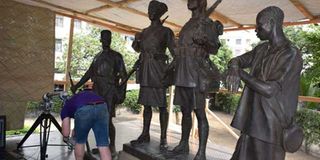UK experts to renovate World War 1 memorials in cities

3D Scanners Specialist Luke Abbott from the UK scans the askari sculptors along Jomo Kenyatta Avenue in Mombasa on February 12, 2018. The Commonwealth War Graves Commission (CWGC) is undertaking a project to record and preserve the World War 1 African Memorials (the Askari memorials). PHOTO | WACHIRA MWANGI | NATION MEDIA GROUP
What you need to know:
Memorials were constructed after WW1 to commemorate all African soldiers and carriers who died in the 1914-18 war.
Mr McDonald said once the sculptures were complete, they were shipped to Africa and put up in prominent urban locations.
The second phase of the project is to begin in June, when the team will be back in Mombasa.
The Commonwealth War Graves Commission is undertaking a project to record and preserve the World War 1 African Memorials (the Askari memorials).
These memorials were constructed after WW1 to commemorate all African soldiers and carriers who died in the 1914-18 war and whose final resting place was unknown.
“As we are now approaching the centenary of the end of World War 1, this project is particularly important as it offers us the opportunity to remember those who lost their lives in this conflict,” said the commission’s Africa technical manager David McDonald in Mombasa.
He added: “The memorials were originally created in London, England, by sculptor James Alexander Stevenson who was appointed “lead architect” by the commission.”
SCULPTURES
Mr McDonald said once the sculptures were complete, they were shipped to Africa and put up in prominent urban locations beginning with Nairobi in 1924, Mombasa in 1926, Dar es Salaam in 1927 and Lagos, Nigeria, in 1931.
The first phase of the project is being undertaken by 3D scanners specialists Luke Abbott and Ben Williams from the UK.
“The 3D scanning process allows us to create a digital replica of the memorials. This phase began in Dar es Salaam on February 7 and the team is currently in Mombasa before finishing work in Nairobi on February 18,” he said.
According to him, this will allow them to have a permanent record of the memorials.
“The 3D scanning process will also allow us to manufacture a number of pieces which have been broken over the years,” he added.
SECOND PHASE
The manager said the second phase of the project is to begin in June, when the team will be back in Mombasa to clean up and repair the memorial to bring it back to its former glory.
“Locals in Mombasa will notice, for example, that the carrier no longer has the staff which he was leaning on. We would like to restore this to make him look more comfortable,” he said.
The commission also plans to provide some visitor information near the monument along Jomo Kenyatta Avenue in Mombasa County to ensure that tourists and locals can understand the history of the memorial and the people it commemorates.
Renowned author and battlefield guide James Willson said the memorials were important reminders of the service and hardships endured during the bitter fighting in the forests, mountains and plains of eastern Africa.
“Next year marks the centenary of the end of The Great War, The First World War,” said the author.





